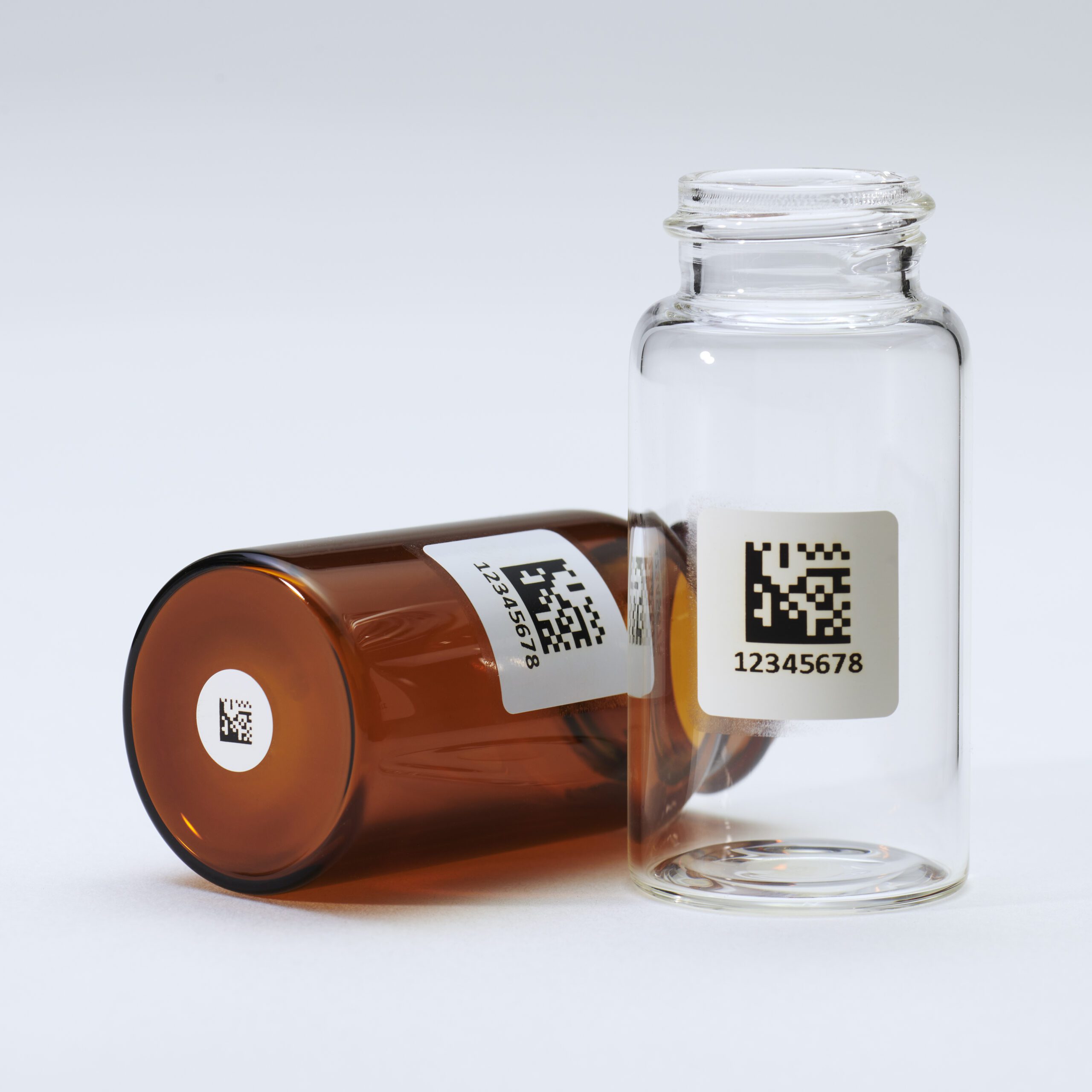Ceramic barcoding technology provides a permanent solution for high-value medical assets. This marking technology is best suited for glass vials and is the most durable solution within our pre-barcoded labware service.
Because the bond between the glassware and the ceramic label is permanent, Ceramic IDs can survive extreme temperature cycles and chemical exposure without affecting the label, protecting the sample’s integrity. Let’s break down everything you need to know about ceramic barcoding.
What is a Ceramic Barcode?
Ceramic barcodes or ceramic IDs are permanent labels guaranteed to survive as long as the container. After printing the barcode onto a special clay, the Ceramic ID will permanently bond to a glass container when fired in a kiln. This method is not compatible with plastic containers due to the high temperatures involved in the bonding process.
Because the label becomes a permanent fixture of the glass vial, this method is highly durable and can withstand extreme temperatures and chemical exposure. When high-value compounds or specimens are on the line, ceramic IDs can help ensure proper identification and eliminate the opportunity for lost or unscannable labels.
Ceramic IDs are permanent and highly durable.
As mentioned above, ceramic labels are durable, especially against chemical exposure and high temperatures. Once bonded to the vial, the label can withstand just about any chemical exposure that won’t impact the integrity of the glass. Ceramic IDs have proven to withstand oven temperatures as high as 500 degrees Celsius, as well as long-term cryogenic storage or acetone ice baths.
Ceramic labeling technology can support stable tare weighing.
Though the weight of adhesives can seem minuscule, if you’re looking for high-accuracy tare weights that remain stable over time, adhesive labels might not cut it. Adhesives are impacted by their environment, including temperature and humidity—leading to changes in weight over time as they dry out or absorb water from the air.
Ceramic labels eliminate that risk because they do not have an adhesive, the ceramic material bonds directly with the glass. Additionally, ceramic labels are generally made from very dense ceramic materials to ensure the mark doesn’t impact sample weight.
Will Ceramic Barcoding suit your laboratory?
Plastic labware cannot utilize Ceramic IDs.
Plastic labware performs better in certain situations. However, due to the labels adhering through processing in a high-temperature kiln, you cannot use ceramic IDs in combination with plastic labware. Instead, if you require plastic labware, you may want to look into direct mark technology or seek a self-laminating pressure-sensitive option engineered to withstand your processes.
Direct Mark technology is better suited for printing color.
Currently, colored inks aren’t compatible with the ceramic labeling process. Printing barcodes along with color with the ceramic material can compromise scannability. If you require color or logo marks on your barcode labels, you may want to reconsider pressure sensitive options or look into direct mark technology. However, while colored inks aren’t available, certain suppliers may have limited offerings to include color. At Computype, we can apply round colored markers on the bottom of a vial for color coding purposes.
You cannot print Ceramic IDs on demand.
Ceramic labeling is not suitable for in-house labeling. The marking, firing, and cooling processes take time, space, labor, and capital. Not to mention, the high heat of the kilns can impact your environment, which may compromise your laboratory. These factors make it impractical to prepare a label for a sample on short notice or in-house.
If you need a print-on-demand solution, we recommend a pressure-sensitive label. If you’re struggling with your current pressure sensitive solution, seek suppliers who provide labels capable of accommodating processes similar to yours or custom engineering.
Justifying the cost of Ceramic IDs
Ceramic IDs are more expensive than other common label materials such as paper or plastic. Consider paper and plastic tableware compared to the cost of ceramic tableware—clay is simply a higher-value material than plastic or paper. If your processes are suited to a ceramic labeling strategy, you will see a return on your investment.
We mentioned several reasons one might want to use ceramic labels, including high-value samples, high heat exposure, and the need for a stable tare weight over time. If any of these factors impact your sample identity integrity in a way that affects your facility monetarily, you’ll likely find justification in a ceramic strategy.
Sourcing Ceramic IDs through our pre-barcoded services
Ceramic labeling is a very straightforward offering within the scope of our pre-barcoded labware program.
For ceramic labels, little customization to the label is required outside of the sequence and label placement—you will choose whether you would prefer a custom or generic sequence, linear or 2D barcodes, or both. Colored circular labels for color coding are also available for the bottoms of vials.
Additionally, with our pre-barcoded labware services, you can also take advantage of a range of optional services, including tare weighing and custom packaging.
At its core, a ceramic labeling strategy is a highly durable marking technology suitable for glass labware. This strategy is a higher investment, but ordering ceramic labeled labware from a trusted supplier in the proper application can provide unmatched sample identity integrity.
Connect with our labelling experts today
Blog article form
"*" indicates required fields

